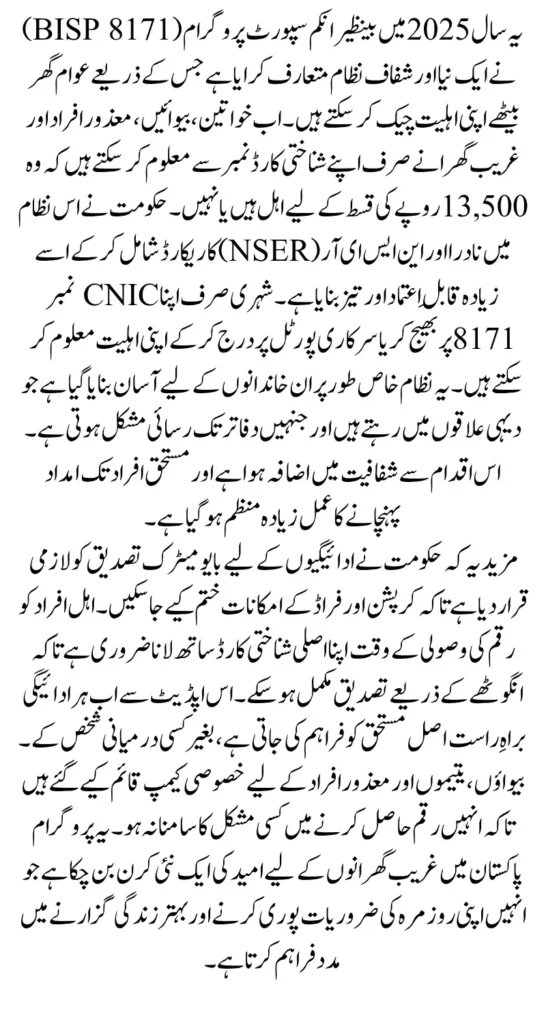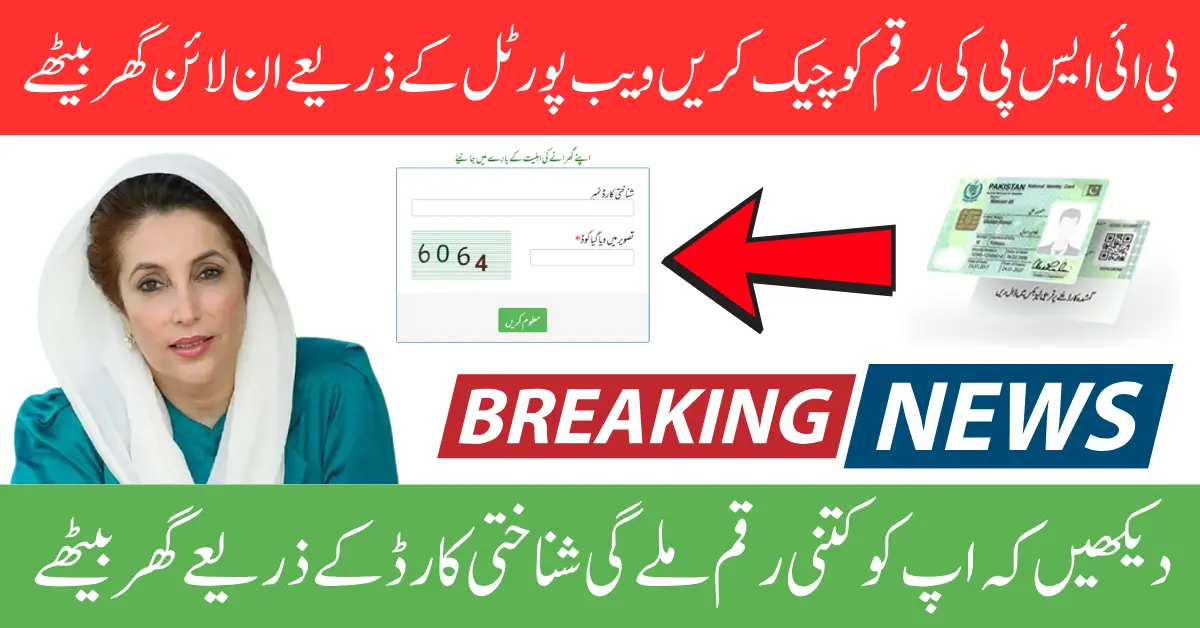BISP Eligibility Check Portal
BISP Eligibility Check Portal continues to stand as Pakistan’s largest welfare initiative, designed to help low-income families meet their basic needs. In 2025, the government has made it even easier for families to verify their eligibility for the new Rs13,500 installment. The BISP 8171 eligibility check portal allows users to confirm their qualification using just their CNIC number through SMS, online verification, or by visiting nearby camps. This system not only saves time but also ensures transparency and fairness in distributing financial support to deserving households across Pakistan.
Through its updated verification process introduced in September 2025, the government aims to remove fake beneficiaries and ensure that funds are directed only to those genuinely in need. With NADRA and NSER integration, BISP 8171 now provides real-time verification results and improved access to payment information. Families can check their status within minutes without visiting any office physically.
You Can Also Read: BISP 8171 Payment Verification Process

What is BISP 8171 and Why It Matters in 2025
The Benazir Income Support Program, widely known as BISP 8171, plays a vital role in poverty reduction. It was created to offer financial relief to poor households who struggle to meet their daily needs such as food, education, and health. Over time, it has evolved with technology, allowing for online verification and digital payments. The 2025 system update further strengthens its transparency through biometric verification and bank-based payments.
This modernization ensures that aid reaches the right people and that the distribution process remains free from corruption or manipulation. Families that meet the government’s eligibility criteria can now receive the Rs13,500 installment more efficiently. The integration of NADRA’s national database with BISP’s own system ensures every applicant’s identity is properly verified before approval.
You Can Also Read: BISP 8171 Nadra Biometric Payment Update
Key focus areas of the 2025 update include:
- Digital verification through CNIC and NSER
- Transparent payment through bank-linked systems
- Prioritization of women-led households and widows
- Dynamic survey to identify newly eligible families
These improvements reflect the government’s commitment to uplifting the weakest segments of society and ensuring a fair system for all citizens.
Eligibility Criteria for BISP 8171 in 2025
To qualify for the BISP 8171 payment of Rs13,500, families must fulfill certain requirements set under the revised rules of September 2025. The main goal of these conditions is to ensure that the aid reaches only deserving people and not those with sufficient income. Applicants must fall within the poverty threshold as defined by the National Socio-Economic Registry (NSER) and must possess valid identification from NADRA.
Eligible applicants include those who live in low-income households, do not hold government jobs, and are not pensioners. The updated criteria also prioritize widows, disabled persons, and women who lead their households. These categories have been recognized as the most financially vulnerable in the current economic situation.
You Can Also Read: BISP 8171 Tracking Portal October 2025
Applicants must meet these main requirements:
- Must belong to a poor or low-income family verified by NSER
- Must have a valid CNIC and be a Pakistani citizen
- Should not be a government employee or pension holder
- Should have a poverty score below the government threshold
- Priority is given to widows, orphans, and disabled individuals
If your family meets the above points, you can proceed to verify your eligibility and check your payment status using the 8171 portal or SMS service.
How to Check BISP 8171 Eligibility
The verification process for BISP 8171 is now simpler than ever. Beneficiaries can confirm their eligibility through three main methods: by sending an SMS, using the online 8171 portal, or visiting local BISP camps established in their districts. Each option is designed to provide accessibility and convenience, especially for those living in rural areas.
The easiest and most popular method is the SMS verification. To use it, open your mobile message box, type your CNIC number without spaces or dashes, and send it to 8171. Within a few seconds, you will receive a reply confirming whether you are eligible for the Rs13,500 installment. This service works on all mobile networks and can be used anytime.
The online 8171 web portal is another efficient method. By visiting the official website, you can enter your CNIC and captcha code to see your eligibility results instantly. This method is ideal for people who have internet access and want to view detailed information about their payments.
The third option is visiting local BISP camps. These camps are set up across different districts to help those who face problems with online systems or SMS replies. At these camps, applicants can submit their CNIC and other documents for verification. If found eligible, they can also collect their payment directly from these centers.
You Can Also Read: CM Punjab E-taxi Scheme Registration Issues
Required Documents for BISP Verification
Applicants must present certain documents during registration or verification to avoid delays. These documents are used to confirm identity, address, and income level. It is recommended to prepare all of them before starting the verification process.
The required documents include:
- Original Computerized National Identity Card (CNIC)
- NSER registration slip or number
- Proof of household income (if available)
- Recent utility bill for address confirmation
- Disability or widow certificate for special categories
Having these documents ready makes the process smoother and ensures faster approval of your eligibility status.
You Can Also Read: PM Electric Bike Scheme Balloting List
PMT Score, NSER, and NADRA Verification Explained
The Poverty Means Test (PMT) score is the backbone of the BISP 8171 eligibility system. It is calculated based on data collected through the National Socio-Economic Registry (NSER) survey. This score determines whether a family qualifies for financial aid or not. A lower score indicates higher eligibility, while a higher score means the family may not fall below the poverty threshold.
The NSER survey continuously updates its data to include newly affected families. NADRA’s verification ensures that CNIC numbers and family records match the government database, preventing duplication or fraud. Together, these systems ensure that financial aid is given only to genuine and deserving families.
Comparison of BISP 8171 Verification Methods
| Verification Method | Time Required | Documents Needed | Where to Apply |
|---|---|---|---|
| SMS (Send CNIC to 8171) | Instant | CNIC number only | Mobile phone |
| Online Portal | 2–3 minutes | CNIC and Captcha Code | 8171.bisp.gov.pk |
| Local BISP Camp | Same Day | CNIC and Supporting Documents | District or Tehsil Camp |
This table helps beneficiaries understand which method suits them best based on convenience, internet access, and document availability.
You Can Also Read: BISP 8171 October 2025 Online Registration
Biometric Payment and Collection of Rs13,500
Once eligibility is confirmed, beneficiaries can collect their payment through the BISP biometric system. This system ensures complete transparency and prevents any kind of fraud or false claims. Payments are usually distributed at partner banks or temporary BISP camps set up in different areas.
During collection, the beneficiary’s thumb impression is verified through NADRA’s database. After successful verification, the Rs13,500 payment is released. In case of any mismatch, the applicant may be required to re-verify their identity at a nearby NADRA office. Beneficiaries are advised to always keep their payment receipts safe for record purposes.
Important reminders:
- Bring your original CNIC for biometric verification
- Do not share SMS confirmation messages with others
- Always check the official BISP receipt after receiving funds
This process ensures that every eligible family receives their financial support directly and securely.
Benefits of the Updated BISP 8171 System
The 2025 update of the BISP 8171 system has brought a number of improvements aimed at making financial support more transparent and efficient. The use of digital technology has reduced delays and helped citizens from remote areas access the program easily. With NADRA integration, payments are now directly linked to verified CNIC numbers, making the entire system more reliable.
Key benefits of the updated BISP system include:
- Fast and transparent verification through NADRA and NSER
- Real-time eligibility status via SMS or web portal
- Secure biometric payments reducing corruption risks
- Equal opportunity for rural and urban applicants
- Special consideration for widows, disabled individuals, and orphans
Through these features, BISP continues to serve as a strong pillar of Pakistan’s poverty alleviation strategy.
You Can Also Read: CM Punjab E-taxi Scheme Repayment Schedule
FAQs
How can I check my eligibility?
You can send your CNIC to 8171, visit the 8171 web portal, or go to a nearby BISP camp for manual verification.
What is the payment amount in 2025?
The current quarterly installment under BISP 8171 is Rs13,500 for qualified families.
Is NSER registration necessary?
Yes, NSER registration is essential as it serves as the primary verification database for all applicants.
Can government employees apply for BISP?
No, government employees and pensioners are not eligible under the new rules.
What if my CNIC has expired?
Visit your nearest NADRA office to renew your CNIC before applying again.
You Can Also Read: BISP 8171 October 2025 Payment Details 13500
Final Words
The BISP Eligibility Check Portal 8171 has made it simpler than ever for Pakistani families to verify and receive their Rs13,500 financial support. Whether you use SMS, the online portal, or visit your local camp, the process is now fast, transparent, and secure.
The government’s focus on NADRA-based verification and NSER updates ensures that only the most deserving families benefit from the program. This initiative continues to empower women, support widows and orphans, and contribute to Pakistan’s vision of reducing poverty through fair and digitalized systems.


